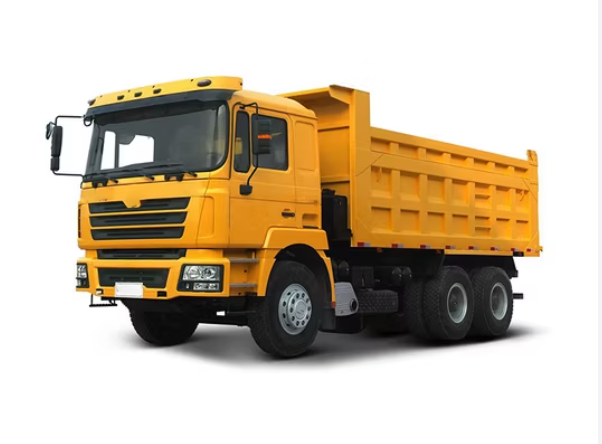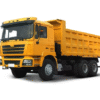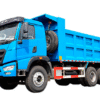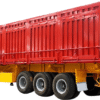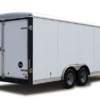If you’ve ever watched a massive dump truck hauling heavy loads and wondered, “How much does a 40-ton dump truck actually weigh?”you’re not alone. As someone who’s spent years around heavy machinery, I can tell you that the answer isn’t as straightforward as you might think. The term “40-ton”can be a bit misleading—it doesn’t always mean the truck itself weighs 40 tons.
When I first started working in construction, I assumed a 40-ton DUMP Truck’s weight was just its gross vehicle weight. But here’s the thing: that number usually refers to its payload capacity, not its actual weight. An empty 40-ton dump truck typically weighs between 25 to 30 tons, depending on the make and model. Add a full load, and you’re looking at a total weight of 65 to 70 tons—now that’s a lot of metal and material moving down the road!
So why does this matter? If you’re in the market for a dump truck or managing a fleet, understanding the difference between curb weight and payload capacity is crucial. Overloading a truck can lead to safety risks, fines, and unnecessary wear and tear. From my experience, always check the Manufacturer’s specs—because when it comes to heavy machinery, guessing just isn’t worth the risk.
What Does “40-Ton” Mean for a Dump Truck?
From my experience, the “40-ton” label on a dump truck can be confusing. It refers to the maximum payload capacity. This is how much material the truck can carry in one trip. This capacity is given in US or metric tons. I think this number is the most important factor if you need a truck for tough hauling jobs.
Payload, Not Truck Weight
I want to make this clear: 40 tons is the payload, not the truck’s total weight. It’s the highest load of material (like gravel, sand, or rock) the truck is built to handle.For example, the Western Star 6900XD 40-Ton Off-Road Hauler is built for a maximum load of 37,000 kg (40 US tons).
Total Loaded Weight vs. Payload
- The Gross Vehicle Mass (GVM) is the truck’s weight plus its maximum payload. For that Western Star 6900XD, the GVM can be as high as 63,000 kg, based on its specific build.
- The empty (curb) weight of a 40-ton dump truck can vary quite a bit. I’ve seen different models with different weights:
- CAMC 40-ton dump truck: lists curb weight at 15,000 kg. I suspect this might be a typo. In my experience, most 40-ton trucks weigh between 35,000–40,000 kg when empty.
- Volvo A40D Articulated Dump Truck: empty weight about 37,000 kg (81,570 lb).
- Caterpillar 740 Articulated Dump Truck: empty weight about 38,000 kg (83,775 lb).
Examples of 40-Ton Dump Trucks
Here are a couple of popular models I often see on job sites:
-
Volvo A40D
- Payload: 40 tons
- Empty weight: 37,000 kg
- Max loaded weight: 68,200 kg
- Engine power: 426 hp
- Load volume: 29.5 cubic yards
-
Caterpillar 740
- Payload: 40 tons
- Empty weight: 38,000 kg
- Max loaded weight: 70,872 kg
- Engine power: 464 hp
- Load volume: 30.5 cubic yards
What to Expect from a 40-Ton Dump Truck
- Overall length: about 10,300 mm (CAMC), or 10.73–11.26 ft (articulated models)
- Box size/body dimensions: A frequent size I see is 7,000 x 2,300 x 1,500 mm (CAMC)
- Engine power: Expect a range between 410–464 hp
- Max speed: around 34–35 mph (55 km/h)
- Heaped capacity (volume): Around 23.5–30.5 cubic meters
- Number of wheels: 6 (articulated), 10–12 (rigid)
My Final Suggestions
- “40-ton” labels the payload, not total vehicle weight.
- When loaded, the total truck weight can top 63,000–70,000 kg (over 150,000 lb), based on the model and build.
- I recommend you also look at other features like engine power, bed size, and wheel setup. These are all built to support the heavy work of carrying 40-ton loads every day.
How Much Do Specific 40-Ton Dump Trucks Weigh? (Examples & Real Models)
From my experience, to understand the weight of 40-ton Dump trucks, it helps to see real models from mining and construction. I’ve gathered a few examples for you. They show both the empty (operating) weight and the full, loaded weight. This list covers different truck types, like articulated and underground models, that all carry a 40-ton payload.
Sandvik TH540 Underground Dump Truck
- Empty (operating) weight: 34,700 kg (34.7 tons)
- Loaded weight: 74,700 kg (74.7 tons)
- Payload: 40,000 kg (40 tons)
- Dump box volume: 22 m³ (range of 18–24 m³)
- I recommend this truck for underground mining. It’s a reliable hauler for the 40-ton class.
Moxy MT 40 B Articulated Dump Truck
- Operating weight (empty): 27,100 kg (27.1 tons)
- Payload (net load): 36,300 kg (36.3 tons)
- Dump capacity: 22.1 m³
- This is a common example from the late ’90s and the 2000s. Its payload is a bit under 40 tons, but I still consider it in the same class.
Volvo A40D Articulated Dump Truck
- Operating weight (empty): 37,000 kg (81,571 lb)
- Payload capacity: 40 tons (standard for modern 40-ton class)
- Dump box capacity: 29.5 yd³ (about 22.6 m³)
- In my opinion, this is a modern benchmark. You see it often in heavy civil and mining operations.
Scania R620 40-Ton Double Trailer Dump Setup
- Modular loaded weight (with two trailers): Up to 267,320 kg (divided across truck and trailers)
- Front section weights: 6,685 kg (front), 5,449 kg (rear), plus trailer and component segments
- This setup is for special heavy-haul jobs. The main truck weight varies because the totals include the full double-trailer configuration.
Weight Summary Table for 40-Ton Dump Trucks
| Model | Empty Weight | Full (Loaded) Weight | Payload | Notes |
|---|---|---|---|---|
| Sandvik TH540 | 34.7 tons | 74.7 tons | 40 tons | Underground mining truck |
| Moxy MT 40 B | 27.1 tons | ~63.4 tons (estimated) | 36.3 tons | Late 90s/2000s articulated |
| Volvo A40D | 37.0 tons | ~77.0 tons (estimated) | 40 tons | Modern articulated truck |
| Scania R620 DT | Modular/varies | Up to 267.3 tons | 40+ tons Dual | Specialized double-trailer setup |
Key Takeaways
- Most 40-ton dump trucks weigh between 27 and 37 tons when empty. This depends on their build and job.
- The total loaded weight ranges from about 63 to 80 tons. Special setups like double-trailers can weigh even more.
- The specific weight depends on the model, configuration, and its working environment (mining, road, or off-road).
My main point is this: the name “40-ton dump truck” describes what the truck can carry, not what it weighs. The truck itself is heavy before you load it with any material.
Factors That Influence a Dump Truck’s Weight
Many things affect a dump truck’s weight, both empty and full. From my experience, if you’re looking at a 40-ton dump truck for a job, these are the details you need to watch.
Truck Size and Body Dimensions
The truck’s size and body dimensions matter. This includes its length, width, and height. A bigger body holds more stuff, but it also adds to the empty weight.
Number and Configuration of Axles
- More axles help spread the weight out. This lets the truck carry heavier loads.
- Each axle also makes the empty truck heavier.
- A five-axle truck, like a semi, can handle much more weight by law than a truck with only three axles.
- You’ll see trucks with more axles when they’re carrying the heaviest loads allowed or working in tough conditions.
Empty (Tare) Weight of the Truck
- The empty weight, or tare weight, is the truck’s weight with nothing in it.
- A heavy-duty dump truck usually has an empty weight around 30,000 pounds.
- I recommend you always start with this number. It’s key for figuring out how much you can safely and legally carry.
Material Density and Type of Load
- The type of material decides the load’s weight. It all comes down to material density.
- Sand: about 2,700 pounds per cubic yard
- Gravel: about 2,800 pounds per cubic yard
- Lighter stuff (mulch or wood chips): around 500 pounds per cubic yard
- As an example, if you fill a 40-ton dump truck with 12 to 16 cubic yards of sand, your load will weigh between 32,400 and 43,200 pounds.
Legal and Regulatory Weight Limits
- On U.S. highways, the total weight of the truck and its load cannot exceed 80,000 pounds.
- Based on my knowledge, some states have different rules. Michigan, for instance, lets trucks weigh up to 164,000 pounds if they have a special permit.
- These laws control the maximum weight your truck can be on the road.
Type and Design of the Dump Truck
- The truck’s design style also changes its weight. Standard dumps, semi-end dumps, and super dumps all have different frames and beds.
- I suggest paying attention to the bed material. A bed made of steel versus aluminum will change the empty weight. Lighter materials like aluminum mean you can carry a heavier payload.
Payload Capacity and Safety Considerations
- I strongly recommend you follow the manufacturer’s official payload rating.
- Overloading is risky. It can damage your truck, make it hard to control, and get you in legal trouble.
- Many heavy-duty trucks can safely carry 13 to 15 tons or more. I advise against pushing past this limit because it’s just not safe.
Weight Compliance and Key Figures
- Typical empty weight: I see most heavy-duty trucks starting around 30,000 pounds.
- Loaded weight: With a load, the total weight is often between 56,000 and 76,000 pounds. This changes based on the material and the truck itself.
- Load calculations: Mulch (500 lbs/cy), sand (2,700 lbs/cy), gravel (2,800 lbs/cy).
- Common payload volume: For sand or gravel, you can expect to haul about 12 to 16 cubic yards.
To sum it up: From my perspective, several key things decide a 40-ton dump truck’s weight. You need to consider the number of axles and the truck’s design. You also must follow weight limits and safety ratings. The type of material you haul is also a major factor. All these pieces work together to determine what your truck actually weighs on the job.
summary
Based on my years of working with these trucks, I’ve learned that weight is about safety and getting the job done right, not just numbers. It doesn’t matter if you are hauling gravel or sand; every pound affects your business’s success.I suggest you learn your truck’s limits. You need to follow all the rules. I also recommend choosing the right equipment for your specific job. The time you put into understanding these details will lead to safer work and help you get more done on every haul.
FAQS
1. Does a “40-ton dump truck” weigh 40 tons?
No, the “40-ton” label typically refers to its payload capacity (how much it can carry), not its actual weight. An empty 40-ton dump truck usually weighs 25–30 tons, while a fully loaded one can reach 65–70 tons.
2. What factors affect a dump truck’s weight?
The weight depends on the truck’s make, model, body material (steel vs. Aluminum), and additional features like reinforced axles or extended beds. Fuel, fluids, and attachments (like tailgates) also add to the total weight.
3. Why is knowing a dump truck’s empty weight important?
Understanding the curb weight (empty weight) helps prevent overloading, which can cause safety hazards, damage roads, and lead to costly fines. Always check the manufacturer’s specs to stay within legal weight limits.
4. How much can a 40-ton dump truck carry?
A true 40-ton dump truck can haul about 40 tons (80,000 lbs) of material. However, real-world capacity may vary slightly based on the truck’s configuration and local weight regulations.
5. Are there different types of 40-ton dump trucks?
Yes! Some are rigid-frame (standard Dump Trucks), while others are articulated (better for rough terrain). Mining dump trucks, for example, are much larger and have higher capacities than typical construction models. Always choose the right type for your job.

